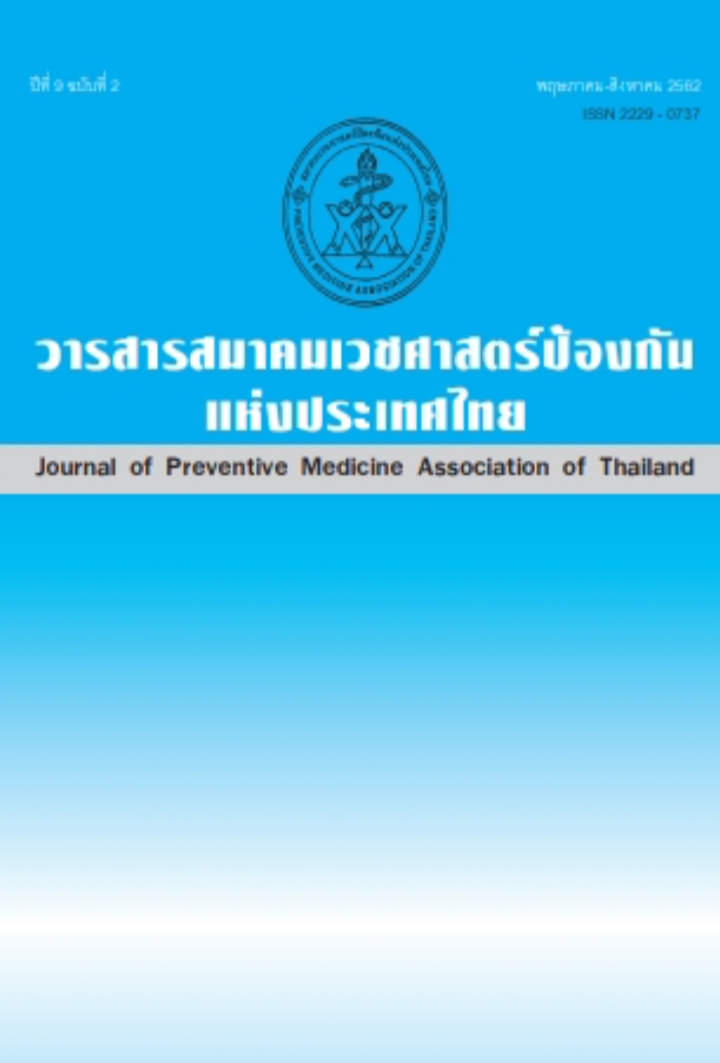A Model Development of Self-care on Chronic Kidney Disease Patients in Community Roi-Et Province
Keywords:
Self-care, Chronic Kidney Disease: CKDAbstract
This research aims to develop a model development of self- care on chronic kidney disease patients in the community and to study the effectiveness of model development in self- care on chronic kidney disease patients in the community. 392 of samples diagnosed by doctors as kidney disease patients through a simple random sampling. The research instruments were a self-care model of chronic kidney disease patients in the community in five steps and the data were collected by questionnaires and record form. The Data were analyzed by mean of frequency, percentage, mean, standard deviation and paired t-test. The result indicated that: a model development of self-care on chronic kidney disease patients in the community had operational processes in five steps: 1) surveying and studying health conditions 2) planning 3) developing the potential care for patients with families, communities and multidisciplinary teams 4) implementing the project according to the plan, and 5) assessing and following up the result of the effectiveness of self-care model on chronic kidney disease patients in the community. After the development of this project found that knowledge of chronic kidney disease in patients increased by 1.75 scores (95% CI: 1.67, 1.98). Also, Risk behavior decreased before development (p=0.001). The risk behavior score decreased by 3.12 points (95% CI: 2.93, 3.38) and the rate of Kidney filtration increased before the development (p=0.001), with the filtration rate of kidneys increase of 9.42 scores (95% CI: -10.74, -8.98).
References
2. Chuasuwan A, Praditpornsilpa K. Thailand renal replacement therapy year 2014. Report of The Nephrology Society of Thailand 2014;29:181-2.
3. สำนักงานสถิติจังหวัดร้อยเอ็ด. รายงานสถิติจังหวัดร้อยเอ็ด ปี พ.ศ. 2560. ส?ำนักงานสถิติแห่งชาติ กระทรวงดิจิทัลเพื่อเศรษฐกิจและสังคม 2560;51-2.
4. Nephrology Society of Thailand. Clinical practice recommendation for the evaluation and management of chronic kidney disease in adults 2015. Bangkok: Nephrology Society of Thailand 2015; 63-9.
5. National Society Nephrology. KDIGO Clinical practice guideline for anemia in chronic kidney disease. Kidney international supplements 2012;2:1-64.
6. Antwi-Bafour S, Hammond S, Adjei JK, Kyeremeh R, Martin-Odoom A, Ekem I. A casecontrol study of prevalence of anemia among patients with type 2 diabetes. J Med Case Rep 2016;10:110.
7. Dalrymple LS, Go AS. Epidemiology of acute infections among patients with chronic kidney disease. Clin J Am SocNephrol 2008;3:1487-93.
8. Hung S, Kuo K, Peng C, Wu C, Wang Y, Tarng D. Association of fluid retention with anemia and clinical outcomes among patients with chronic kidney disease 2015; 150-52.
9. Ryu SR, Park SK, Jung JY, Kim YH, Oh YK, Yoo TH, et al. The prevalence and management of anemia in chronic kidney disease Patients: Result from the korean cohort study for outcomes in patients with chronic kidney disease (KNOW-CKD). J Korean Med Sci 2017;32:249-56. Doi:10.3346/jkms.2017.32.2.249
10. สุปราณี สูงแข็ง, สมพร แวงแก้ว. การวิเคราะห์ปัจจัยที่มีอิทธิพลต่อการเกิดภาวะไตเรื้อรังในผู้ป่วยเบาหวานในจังหวัดอุดรธานี. วารสารสำนักงานป้องกันควบคุมโรคที่ 7 ขอนแก่น 2560;24:1-8.
11. ชัชวาล วงค์สารี, จริยา กฤติยาวรรณ. การให้ความรู้แบบเข้มข้นเพื่อบำบัดภาวะน้ำเกินในผู้ป่วยโรคไตวายเรื้อรังระยะสุดท้ายที่ฟอกเลือดด้วยเครื่องไตเทียม: บทบาทพยาบาลไตเทียม. วารสาร มฉก.วิชาการ 2560;21:146.
12. สิรนันท์ กลั่นบุศย์, ลลิตตา มณีโชติ, วงศ์ผกา เลิศไชยภัณฑ์, วรรณคล เชื้อมงคล. ผลการให้คำปรึกษาเรื่องโรคและยาในผู้ป่วยโรคไตเรื้อรัง ณ แผนกผูป่วยนอก โรงพยาบาลพระพุทธบาท จังหวัดสระบุรี. เสวนาสารเภสัชกรรมและบริการสุขภาพ 2557;1:68-9.
13. Yamane T. Statistics: An introductory analysis. 3rd ed. New York: Harper and Row 1973;152-53.
14. Campbell DT, Stanley JC. Experimental and quasi-experimental design for research. Hope-Well, NJ: Houghton Mifflin 1963; 60-61.
15. พงษ์เดช สารการ. ชีวสถิติพื้นฐานและการวิเคราะห์ข้อมุล: STATA. ขอนแก่น: โรงพิมพ์มหาวิทยาลัยขอนแก่น; 2558. หน้า 60.
16. อรุณ จิรวัฒน์กุล. สถิติทางวิทยาศาสตร์สุขภาพเพื่อการวิจัยที่ใช้ในงานวิจัยทางวิทยาศาสตร์สุขภาพ.กรุงเทพฯ: วิทยพัฒน์; 2552. หน้า 52.
17. กิติมา เศรษฐ์บุญสร้าง, ประเสริฐ ประสมรักษ์. การพัฒนารูปแบบการดูแลของผู้ป่วยโรคไตวายเรื้อรังระยะสุดท้ายที่ได้รับการบำบัดทดแทนไตต่อพฤติกรรมการดูแลตนเองและคุณภาพชีวิตผู้ป่วย โรงพยาบาลสมเด็จพระยุพราชเลิงนกทา จังหวัดยโสธร. วารสารการพัฒนาสุขภาพชุมชน มหาวิทยาลัยขอนแก่น 2559;4:486-503.
18. สุภาพร องค์สุริยานนท์. การพัฒนาพฤติกรรมการดูแลตนเองของผู้ป่วยโรคไตเรื้อรังโรงพยาบาลเจ้าพระยายมราช จังหวัดสุพรรณบุรี. วารสารสาธารณสุขและการพัฒนา 2551;6:32-8.
19. Green LW, Kreuter MW. Health Program Planning an Educational and Ecological Approach. 4th ed. New York: McGraw-Hill; 2005.
20. กรมสนับสนุนบริการสุขภาพ กระทรวงสาธารณสุข. การศึกษาสถานการณ์ความรอบรู้สุขภาพและพฤติกรรมสุขภาพของกลุ่มเสี่ยง/ความดันโลหิตสูง. นนทบุรี: โรงพิมพ์กองสุขศึกษา; 2556. หน้า 136-7.
21. Powell SK. Case management: A practical guide for education and Practice. Philadelphia:Lippincott-Raven; 2000. p. 120-25.
22. อัมพรพรรณ ธีรานุตร, นงลักษณ์ เมธากาญจนศักดิ์, ปัทมา สุริต, วาสนา รวยสูงเนิน, ดลวิวัฒน์ แสนโสม, จันทร์โท ศรีนา, และคณะ. การพัฒนาระบบบริการสุขภาพเพื่อชะลอการล้างไตในผู้ป่วยโรคไตเรื้อรัง. ขอนแก่น: โรงพยาบาลชุมแพ; 2560. หน้า 57.
23. Ryan P, Sawin KJ. The individual and family self-management theory: Background and perspectives on context process and outcomes. Nursing outlook 2009;57:217-25.
24. วริยา เสนาฮาด. การพัฒนารูปแบบการชะลอไตเสื่อมในผู้ป่วยโรคเบาหวานโรงพยาบาลส่งเสริมสุขภาพตำบลดงใหญ่ อำเภอวาปีปทุม จังหวัดมหาสารคาม. มหาสารคาม: สำนักงานสาธารณสุขอำเภอวาปีปทุม; 2561. หน้า 167-8.
25. ประภารัตน์ ประยูรพรหม, จุฑารัตน์ บางแสง, สมควร พิรุณทอง, อภิญญา สัตย์ธรรม. การพัฒนาแนวปฏิบัติการพยาบาลผู้ป่วยโรคไตเรื้อรังโรงพยาบาลชัยภูมิ.วารสารกองการพยาบาล 2559;43:11-33.
26. ชัชวาล วงค์สารี. ผลของโปรแกรมการให้ความรู้แบบเข้มข้นต่อความรู้และพฤติกรรมการจำกัดน้ำของผู้ป่วยโรคไตวายเรื้อรังระยะสุดท้ายที่ฟอกเลือดด้วยเครื่องไตเทียม. สมุทรปราการ: มหาวิทยาลัยหัวเฉียวเฉลิมพระเกียรติ; 2557. หน้า 201-3.
27. เบญจมาส เรืองดิษฐ์, เสาวลักษณ์ อุไรรัตน์,ชูลินดา สะมะแอ. การพัฒนาพฤติกรรมการดูแลตนเองสำหรับผู้ป่วยโรคไตเรื้อรังในเครือข่ายบริการสุขภาพระดับปฐมภูมิ โรงพยาบาลสงขลา. วารสารเครือข่ายวิทยาลัยพยาบาลและการสาธารณสุขภาคใต้ 2559;3:194-207.
28. สุนิสา สีผม. การจัดการตนเองในผู้ป่วยโรคไตเรื้อรัง. วารสารพยาบาลสภากาชาดไทย 2556;6:12-8.
29. นฤมล แก่นสาร. การพยาบาลผู้ป่วยโรคไตเรื้อรังระยะสุดท้ายที่ได้รับการล้างไตทางช่องท้อง แบบต่อเนื่องที่มีการติดเชื้อของเยื่อบุช่องท้อง:กรณีศึกษา 2 ราย. วารสารโรงพยาบาลมหาสารคาม. 2558;12:81-91.
Downloads
Published
How to Cite
Issue
Section
License
บทความที่ลงพิมพ์ในวารสารเวชศาสตร์ป้องกันแห่งประเทศไทย ถือเป็นผลงานวิชาการ งานวิจัย วิเคราะห์ วิจารณ์ เป็นความเห็นส่วนตัวของผู้นิพนธ์ กองบรรณาธิการไม่จำเป็นต้องเห็นด้วยเสมอไปและผู้นิพนธ์จะต้องรับผิดชอบต่อบทความของตนเอง






